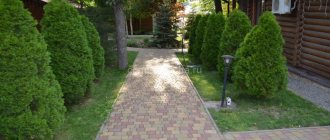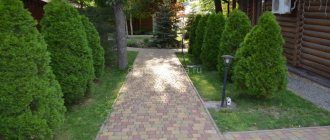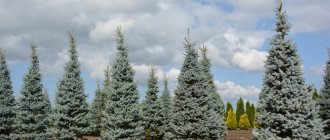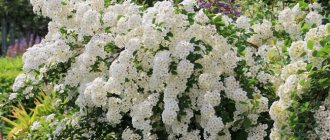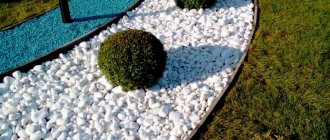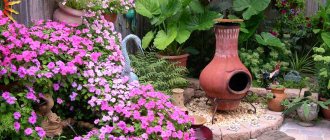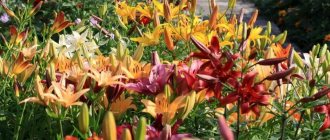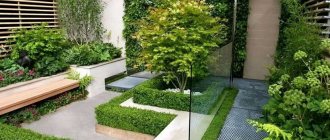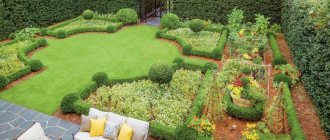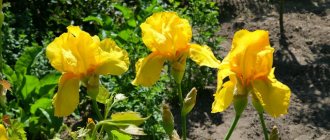Happy owners of country plots and dachas have an excellent opportunity to relax in the lap of nature and enjoy the fresh air. Modern dachas are no longer just six acres of vegetable garden and a few fruit trees; today, owners of country estates are trying to arrange the landscape of their plots as comfortably as possible in order to simply take a break from the noisy and dusty city.
Landscape design of the site comes to the rescue - the science responsible for the improvement and beautification of the local area. Designer services are not cheap, but you can try to arrange the landscape of your summer cottage yourself. To do this, you need to know some landscape tricks - this article will be about them.
Make a plan
Most flaws and failures in landscape design are the result of ill-considered actions and unaccounted for circumstances.
The solution is obvious - you need a detailed plan. It is necessary to note everything on it, from the location of buildings and the distribution of communications, ending with garden paths, landscaping and lighting. You can draw a diagram on paper, but why, if progress has gone far ahead? Trick #1: Use a free computer program to create and print a visual design project of your site.
Landscape design of a private house on 6 acres
6 acres (600 sq.m.) is enough for landscape design, including the arrangement of all key areas of the territory. Multi-level terraces and vertical flower beds will save space, and instead of large trees it is better to plant small fruit trees.
The plan shows the location of all objects.
They indicate the boundaries of the territory, communications - gas, electrical cables, water supply and sewerage. Trees should not be planted near utility lines.
Choose a style
When no idea can be traced in the landscape, the estate looks faceless, and sometimes completely plunges into chaos and bad taste. Therefore, even at the stage of constructing a house and household buildings, decide on the design direction, and arrange the garden in accordance with it.
Trick #2: choose a style that imitates the natural environment, such as English, French or Tyrolean, then the site will look picturesque and well-groomed with a minimum of effort and cost.
Place accents
Accents in landscape design are expressive elements of the landscape that set the mood and reveal the concept of style. These are flower beds, gazebos, artificial ponds, garden sculptures, original plants - whatever your imagination can do.
Trick No. 3: a small plot should have the “heart” of the composition - one accent, but on the expanses of a large estate it is permissible to place several accents.
The simplest diagram of a flower bed of perennials
The composition should be uniform, laconic, where there is nothing superfluous, and at the same time, such flower beds look like a complete work of landscape design. Usually, beginning gardeners are advised to select unpretentious plants, which, nevertheless, are quite beautiful.
Here is one such successful combination:
- Pink astilbe. Flowering of this variety lasts from late June to mid-August; the plant loves loosening and regular feeding.
- Geranium is magnificent. Lush flowering begins in mid-summer and ends only at the end of the entire flower season, resulting in a luxurious lush bush with light purple flowers.
- Paniculate phlox is purple or pink. They need to be planted in September or mid-March; this flower takes root well in sandy, well-drained soil, and it blooms from mid-July until autumn.
- Purple-silver daylily. These plants should be planted in spring in well-drained, loose loam.
- Heuchera with lavender leaves. Loves light soils without stagnant water, flowering occurs from May to July.
This solution will decorate a cozy garden; it looks good under large windows. You can also design a front garden; in the far part of the garden such a plan is not so effective. A similar flower bed along a fence or path looks beautiful if the composition is balanced with something on the other side. For example, a lush island of bushes.
Plant flower beds
Without a flower bed, mixborder, rock garden, vertical garden or alpine slide, it is difficult to imagine a cozy estate, regardless of the chosen style. The size, number and location of flower beds depend on the free space.
On a large plot, large isolated objects are appropriate, but on a small plot it is better to plant compact plants and as closely as possible - for example, lay out a front garden near a house or organize a rose garden in the garden. It is important to choose the right crops.
Trick number 5: use conifers and perennials with different flowering periods in order to fuss less with them and always enjoy a beautiful landscape.
Landscape planning
The very first thing you need to start your own project with is drawing up a landscape plan on paper.
Advice! For convenience, you can use one of the special programs for landscape designers.
Before sitting down at a desk with a computer and a pen, you need to visit a suburban area to examine the features of the landscape, take soil samples, and calculate where the groundwater flows.
So, work on developing a landscape begins with the following steps:
- Drawing on paper the exact boundaries of the site in accordance with the scale.
- Marking of structures already standing on the site (residential building, garage, sheds and outbuildings).
- An image of those landscape objects that still need to be completed. Moreover, absolutely all buildings should be transferred to paper, right down to the dog house. This is important, since even on a large area of land, when developing a landscape, there is always not enough space.
- If the area is large, it is better to divide the landscape into segments in the form of squares. In each square, one or another landscape object is marked. This will make it much easier to transfer the plan to the real area.
- Transferring perennial plants and trees already growing on the site onto paper.
- Marking the site in relation to buildings and perennials, suggesting the planting of new large plants and trees. At this stage, we should not forget about the intervals between plantings and buildings.
- A plan representation of existing and necessary communications and systems, such as water supply, electricity, sewerage or drainage, passing through the site.
Attention! When the site plan is ready, the owner needs to once again inspect the landscape of his dacha and decide whether he will leave the existing terrain with all the hills and possible elevation changes, or whether the surface of the site needs to be leveled.
Make paths
Paths make moving around the site convenient and at the same time act as an important component of landscape design. At the same time, everything that is difficult to maintain quickly becomes a “hole” in the composition and spoils the impression of the garden.
Therefore, you need to choose practical materials for walkways, such as stone slabs, pebbles or crushed stone. And the paths should have a well-thought-out direction.
Trick number 6: lay a minimum of garden paths and so that they do not lead the eye right through the entire area - this will visually make it more crowded.
The basis of the landscape is the lawn
It is the lawn that becomes the background on the basis of which the entire future composition is built (this is like the covering and color of the walls when designing a room). A landscape without an even lawn looks unkempt and disorderly - only professionals can make such compositions beautiful.
Some landscape tricks will help you create a lawn yourself:
- selection of the appropriate type of lawn. For example, an English lawn is suitable for a landscape with many paths and paths. This type of soft grass cannot be walked on; moreover, it is capricious in terms of watering and care. Sports turf is loved for its practicality - dense grass can serve as a carpet for a playground or recreation area. A meadow lawn consists of grasses and wildflowers; you don’t have to cut it, it looks very natural in the landscape, but you can’t walk on soft grass. Landscape lawns are universal, can cover any landscape and topography, are easy to care for, but are not very attractive.
- It is necessary to choose the type of lawn grass in the fall. To do this, inspect the landscape of the site, perform drainage if necessary, think over an irrigation system, and add nutritious turf. The lawn should be planted in early spring, otherwise the fragile grass will not take root.
- Lawn grass seeds are very small; to distribute them evenly over the area, it is necessary to mix the planting material with coarse river sand.
- If the lawn is not watered regularly, the grass will turn yellow and begin to dry out, which will certainly spoil the landscape.
- Beginners should consider buying a ready-made lawn, which will be delivered in rolls and simply unrolled on the prepared area.
Important! Even professionals cannot get a uniform lawn surface the first time. You will have to monitor the germination of the seeds and re-sow them in places where there are “bald spots”.
Use guardrails
A spectacular stone or forged fence, a carved wooden fence with a gate - all these are parts of landscape design that can add points to the originality score. The height and type of fences are determined by the rules of the garden association and the area of the allotment. Tiny areas should not be surrounded by a high fence around the entire perimeter, much less cut into pieces. There is only one universal exception.
Trick number 7: use hedges of different heights and densities, which blend perfectly with other plantings and allow you to gently emphasize zoning.
Little tricks of big masters: whists
One of the effective techniques, using which it is possible to highlight the advantages of the site and disguise the disadvantages, is whists. This is a view that opens up beautiful perspectives, takes you into the distance of the territory and mysteriously beckons. Using whist, the depth of the garden is emphasized. To better understand what exactly we are talking about, you should try to imagine a picture depicting your garden, determine the point from which the territory will be viewed - it is from this point that the vista should be formed.
The frames of such paintings are the “scenes” of the so-called foreground; all attention is focused on it. At the same time, everything else should visually remain behind these “scenes”. Various types of structures and outbuildings often act as such a framework. In addition, bushes and trees can be used as a frame.
The background is formed with the help of flower beds, shrubs and flowers. The main focal point should be placed in the foreground, i.e., up to the point of view; for example, a flowering pink bush with large inflorescences or a small waterfall made with your own hands would work well in its role. Bright ornamental crops should be planted diagonally from the viewing point - these secrets provide an opportunity to visually increase the area of the territory. Distant perspectives should be closed by a row of trees that have pyramidal or vertical crowns - the optimal use here is of junipers, spruces or cypresses.
The above is just a small part of the secrets and tricks from the world of modern landscape designers - there are many more, and not every professional master in such matters is ready to share with a wide audience his personal secrets, repeatedly used successfully in practice. Nevertheless, nowadays there is an excellent program called “Landscape Tricks”, in which many useful tips for arranging plots with your own hands, even from scrap materials, are discussed in detail.
But the most important thing in this process is the understanding that if optical effects are used correctly, this will open up the widest possibilities for visually changing the border of the territory. Understanding this, using the tricks and advice of professional craftsmen, you can create with your own hands a unique landscape design that will look as harmonious as possible and be combined with all the buildings located on the site, not only in shape, but also in color. Moreover, this can be done even from scrap materials.
Author: S. Rozanova
Consider the lighting
The perception of landscape is highly dependent on lighting. In the evening, when the sun goes down, you determine how and with what lighting your estate is illuminated. Spot, pendant and ground-mounted garden lamps not only decorate the landscape and draw attention to the most picturesque corners, but also provide safe, comfortable movement.
Trick #8: Temporarily place the lights in the desired areas of the garden and see what the effect is before fixing them in place.
Combine colors wisely
The secret of the beauty and harmony of natural landscapes lies in the color scheme. It can be bright and variegated, but the number of plants in one area is always limited by the conditions of the ecosystem. This is a kind of insurance against bad taste.
Trick number 9: select ornamental crops for the garden in such a way as to use no more than 6 flowers, and for a tiny estate, limit yourself to 2-3 flowers or arrange a monoflower.
Landscape color palette
Even a modest-sized area can be made unforgettably beautiful, and correctly selected colors of the composition play a very important role in this.
The following groups of objects and their shades are important for a harmonious landscape:
- fragments of the natural landscape. This group includes trees and shrubs, natural reservoirs located on the site, stones and hills. If a decision is made to leave the natural topography of the site, care should be taken to ensure its compatibility with new landscape objects. Therefore, you need to choose seasonal flowers and evergreen shrubs, because at different times of the year the entire composition will change, the shades of the landscape elements should be in harmony with each other.
- Architectural objects on the site, such as a house, garage, bathhouse, terrace and gazebo, do not have to be the same color. It is important to maintain harmony and use generalizing elements of the landscape. For example, cover all buildings on the site with the same tiles, or use natural wood in architecture. Contrasting objects that differ from the rest and act as the center of the composition also look beautiful in the landscape.
- Decorative landscape and its objects, such as ponds, flower beds, rock gardens and terraces, can be either monochromatic or variegated, multi-colored. Here it is important not to overdo it, to make the ensemble look complete and natural. Evergreen plants in approximately the same color scheme, which do not change shade depending on the time of year, look good and laconic in landscapes.
Advice! Small details, such as sculptures, flowerpots, swings or benches, will help you adjust the size and shape of the area. By playing with the color of additional details, you can achieve an interesting result and take a fresh look at your site.
Look to the future
Plants with a long development cycle will not always look the same as the day they were planted. This is especially true for trees, shrubs and bindweeds. You can accurately predict what size they will reach, what shape they will take, and how far they will grow. In a few years, under the influence of these factors, the appearance of your estate will change.
Trick #10: When selecting and planting large crops, consider how much space they will take up in the future and where they will cast shadows.
